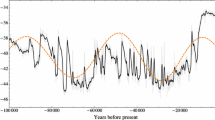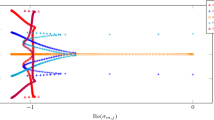Abstract
We analyze the stability of an idealized model of the Atlantic meridional overturning circulation by adopting a two-dimensional Boussinesq model. We define a two-dimensional parameter space descriptive of the freshwater forcing of the system and determine a bounded region on which multiple equilibria are realized. We also analyze the dependence of the response of the system to finite amplitude perturbations in the boundary conditions with different rates of change. It is possible to define a robust separation between slow and fast regimes of forcing. The critical rate of increase is similar to the ratio of the typical intensity of the hydrological cycle to the advective time scale of the system. If the change of the forcing is faster (slower) than the critical rate, the system responds as to instantaneous (adiabatic) changes of the same amplitude. Since the advective time scale is proportional to the square root of the vertical diffusivity, our analysis supports the conjecture that the efficiency of vertical mixing might be critical in determining the response of the ocean circulation to transient climatic changes.
Similar content being viewed by others
References
A. Arakawa, “Computational Design for Long-Term Numerical Integration of the Equations of Fluid Motion: Two-Dimensional Incompressible Flow. Part I,” J. Comput. Phys. 1, 119–143 (1966).
A. Baumgartner and E. Reichel, The World Water Balance (Elsevier, New York, 1975).
E. A. Boyle and L. Keigwin, “North Atlantic Thermohaline Circulation during the Past 20000 Years Linked to High-Latitude Surface Temperature,” Nature 330, 35–40 (1987).
W. S. Broecker, “Massive Iceberg Discharges as Triggers for Global Climate Change,” Nature 372, 421–424 (1994).
F. Bryan, “High-Latitude Salinity Effects and Interhemispheric Thermohaline Circulations,” Nature 323, 301–304 (1986).
F. Bryan, “Parameter Sensitivity of Primitive Equation Ocean General Circulation Models,” J. Phys. Oceanogr. 17, 970–985 (1987).
P. Cessi and W. R. Young, “Multiple Equilibria in Two-Dimensional Thermohaline Flow,” J. Fluid Mech. 241, 291–309 (1992).
F. Dalan, P. H. Stone, I. Kamenkovich, and J. Scott, “Sensitivity of the Ocean’s Climate to Diapycnal Diffusivity in EMIC. Part I: Equilibrium State,” J. Climate 18, 2460–2481 (2005).
H. A. Dijkstra and J. Molemaker, “Symmetry Breaking and Overturning Oscillations in the Thermohaline Driven Flows,” J. Fluid Mech. 331, 169–198 (1997).
H. A. Dijkstra, Nonlinear Physical Oceanography (Kluwer, Dordrecht, 2001).
A. Ganopolski and S. Rahmstorf, “Abrupt Glacial Climate Changes due to Stochastic Resonance,” Phys. Rev. Lett. 88, 038501 (2002).
M. C. Gregg, T. B. Sanford, and D. P. Winkel, “Reduced Mixing from the Breaking of Internal Waves in Equatorial Waters,” Nature 422, 513–515 (2003).
R. T. Knutti, T. W. Stocker, and D. G. Wright, “The Effects of Subgridscale Parameterizations in a Zonally Averaged Ocean Model,” J. Phys. Oceanogr. 54, 2738–2752 (2000).
V. Lucarini and P. H. Stone, “Thermohaline Circulation Stability: a Box Model Study — Part I: Uncoupled Model,” J. Climate 18, 501–513 (2005).
V. Lucarini and P. H. Stone, “Thermohaline Circulation Stability: a Box Model Study — Part II: Coupled Model,” J. Climate 18, 514–529 (2005).
V. Lucarini, S. Calmanti, and V. Artale, “Destabilization of the Thermohaline Circulation by Transient Perturbations to the Hydrological Cycle,” Clim. Dyn. 24, 253–262 (2005).
S. Manabe and R. J. Stouffer, “The Role of Thermohaline Circulation in Climate,” Tellus 51A–B, 91–109 (1999).
S. Manabe and R. J. Stouffer, “Are Two Modes of Thermohaline Circulation Stable?” Tellus 51A, 400–411.
J. Marotzke, “Analysis of Thermohaline Feedbacks,” in Decadal Climate Variability: Dynamics and Predictability, Ed. by D. L. T. Anderson and J. Willebrand (Springer, Berlin, 1996), pp. 333–378.
D. W. Peaceman and H. H. Rachford, “The Numerical Solution of Parabolic and Elliptic Differential Equations,” J. Soc. Ind. Appl. Math. 3, 28–41 (1955).
S. Rahmstorf, “Bifurcations of the Atlantic Thermohaline Circulation in Response to Changes in the Hydrological Cycle,” Nature 378, 145–149 (1995).
S. Rahmstorf, “On the Freshwater Forcing and Transport of the Atlantic Thermohaline Circulation,” Clim. Dyn. 12, 799–811 (1996).
S. Rahmstorf, “Ocean Circulation and Climate during the Past 120,000 Years,” Nature 419, 207.
A. Schmittner and T. F. Stocker, “The Stability of the Thermohaline Circulation in Global Warming Experiments,” J. Climate 12, 1117–1127 (1999).
P. H. Stone and Y. P. Krasovskiy, “Stability of the Interhemispheric Thermohaline Circulation in a Coupled Box Model,” Dyn. Atmos. Oceans 29, 415–435 (1999).
R. J. Stouffer and S. Manabe, “Response of a Coupled Ocean-Atmosphere Model to Increasing Atmospheric Carbon Dioxide: Sensitivity to the Rate of Increase,” J. Climate 12, 2224–2237 (1999).
L. Talley, “Shallow, Intermediate, and Deep Overturning Components of the Global Heat Budget,” J. Phys. Oceanogr. 33, 530–560 (2003).
O. Thual and J. C. McWilliams, “The Catastrophe Structure of Thermohaline Convection in a 2-Dimensional Fluid Model and a Comparison with Low-Order Box-Models,” Geophys. Astrophys. Fluid Dyn. 64, 67–95 (1992).
S. Titz, T. Kuhlbrodt, and U. Feudel, “Homoclinic Bifurcation in an Ocean Circulation Box Model,” Int. J. Bif. Chaos 12, 869–875 (2002).
C. Wunsch and R. Ferrari, “Vertical Mixing, Energy, and the General Circulation of the Oceans,” Annu. Rev. Fluid Mech. 36, 281–314 (2004).
Author information
Authors and Affiliations
Rights and permissions
About this article
Cite this article
Lucarini, V., Calmanti, S. & Artale, V. Experimental mathematics: Dependence of the stability properties of a two-dimensional model of the Atlantic ocean circulation on the boundary conditions. Russ. J. Math. Phys. 14, 224–231 (2007). https://doi.org/10.1134/S1061920807020124
Received:
Revised:
Issue Date:
DOI: https://doi.org/10.1134/S1061920807020124




